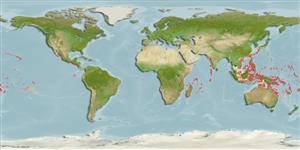Actinopterygii (ray-finned fishes) >
Scorpaeniformes (Scorpionfishes and flatheads) >
Scorpaenidae (Scorpionfishes or rockfishes) > Scorpaeninae
Etymology: Scorpaenopsis: Latin, scorpaena = a kind of fish, 1706 + Greek, opsis = appearance (Ref. 45335); vittapinna: From the Latin vitta for band and pinna for fin, in reference to the dark transverse band on the anal and pelvic fins. Not in Ref. 40966.. More on author: Randall.
Environment / Climate / Range
Ecology
Marine; reef-associated; depth range 2 - 28 m (Ref. 42181). Tropical, preferred ?
Indo-Pacific: Red Sea and East Africa to the Society Islands. Expected to be eventually recorded from Japan, Taiwan, or Australia.
Size / Weight / Age
Maturity: Lm ? range ? - ? cm
Max length : 8.5 cm TL male/unsexed; (Ref. 90102)
Short description
Morphology | Morphometrics
Dorsal
spines
(total): 12;
Dorsal
soft rays
(total): 9;
Anal
spines: 3;
Anal
soft rays: 5;
Vertebrae: 24. A broad dark band across soft portion of anal and pelvic fins. Maxilla extending posterior to a vertical at rear edge of orbit. Interorbital ridges low, flaring laterally to base of tympanic spines; no median interorbital ridge. Occipital pit shallow, its anterior edge inwardly curved. A small but deep suborbital pit. Suborbital ridge with 4 retrorse spines, the first on lacrimal; posterior points divided into 2 points (except in young). Supraocular tentacle varying from smaller than spine to as long as orbit diameter. Upper opercular spine usually double (may be divided into 3 or 4 points); lower opercular spine usually single (rarely double) (Ref. 42181).
Inhabits coral reefs and areas with rubble bottom (Ref. 42181).
Life cycle and mating behavior
Maturity | Reproduction | Spawning | Eggs | Fecundity | Larvae
Randall, J.E and W.N. Eschmeyer, 2001. Revision of the Indo-Pacific scorpionfish genus Scopaenopsis, with descriptions of eight new species. Indo-Pac. Fish. (34):79 p. (Ref. 42181)
IUCN Red List Status (Ref. 115185)
CITES (Ref. 94142)
Not Evaluated
Threat to humans
Harmless
Human uses
More information
Common namesSynonymsMetabolismPredatorsEcotoxicologyReproductionMaturitySpawningFecundityEggsEgg development
Age/SizeGrowthLength-weightLength-lengthLength-frequenciesMorphometricsMorphologyLarvaeLarval dynamicsRecruitmentAbundance
ReferencesAquacultureAquaculture profileStrainsGeneticsAllele frequenciesHeritabilityDiseasesProcessingMass conversion
Tools
Special reports
Download XML
Internet sources
